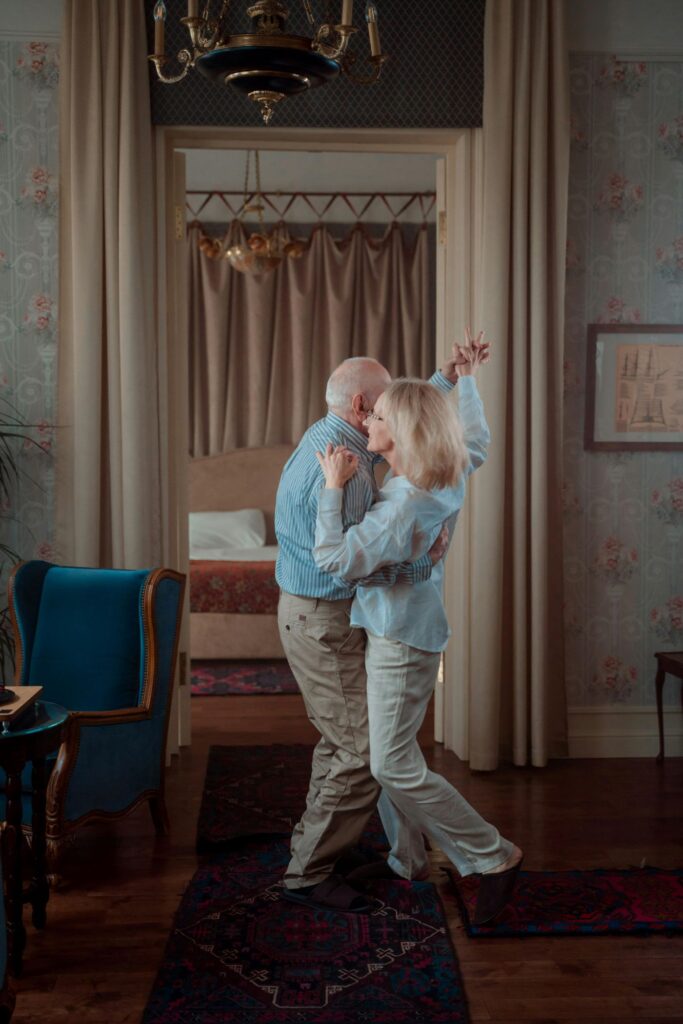Body movement Therapy
The Incredible Benefits of Dancing for the Elderly
Incorporating dance into the lives of the elderly brings forth a multitude of benefits that extend beyond just the physical aspect. Dance has the remarkable ability to enhance the overall well-being of seniors, be it the improvement of cognitive function, mental stimulation, or social interaction.
Research has consistently shown that dancing helps improve balance, flexibility, and strength, which are vital for preventing falls and maintaining independence. Additionally, the rhythmic movements, coordination, and patterns involved in dancing stimulate the brain and boost cognitive abilities. Socially, dancing creates a sense of community and belonging, reducing feelings of isolation and loneliness among the elderly.
Whether it’s ballroom, line dancing, or even just a casual gathering to enjoy some music and movement, dancing has proven to be a wonderful way to promote physical, mental, and social well-being for seniors. So put on those dancing shoes and let the rhythm guide you to a healthier and happier life!

Physical Benefits of Dancing for the Elderly
Dancing provides several physical benefits to the elderly. Regular dancing practice promotes cardiovascular health, endurance, and general fitness. Dance routines combine aerobic exercise and muscle activation, which strengthens the heart and enhances lung capacity, lowering the risk of cardiovascular diseases.
Dancing also improves flexibility, coordination, and agility, allowing elders to maintain proper posture and balance. The repetitive motions in dance routines also help to develop muscle strength and joint mobility.
Dancing, as a weight-bearing activity, aids in the prevention of bone loss and osteoporosis, hence maintaining skeletal strength and health. general, dancing is a fun and entertaining approach for the elderly to keep active, maintain physical fitness, and improve their general well-being.
Mental and Cognitive Benefits of Dancing for the Elderly
Aside from its physical benefits, dancing has a tremendous impact on the elderly’s mental and cognitive health. According to research, dance activates the brain and improves cognitive functions like memory, attention, and problem-solving abilities. Dance routines demand complicated motions, rhythms, and coordination, which challenge the brain and strengthen neural connections.
This can assist to decrease cognitive decline and lower the likelihood of age-related neurodegenerative disorders including dementia and Alzheimer’s. Dancing also improves mood and mental health by producing endorphins, or “feel-good” hormones that can ease symptoms of despair and anxiety.
Dance activities provide a cerebral workout, develop mental sharpness, and improve overall cognitive capacities, making them an excellent activity for seniors to adopt into their daily lives.

Emotional and Social Benefits of Dancing for the Elderly
Aside from the physical and cerebral benefits, dancing provides considerable emotional and social benefits for the elderly. Seniors who participate in dance courses or social dancing events feel more connected and less lonely.
Dancing in a group context promotes social contact, communication, and new connections. The common experience of studying and performing dance routines fosters a friendly and inclusive community. Furthermore, dance allows seniors to express themselves creatively, which increases self-esteem and confidence.
Dancing provides joy, excitement, and a sense of success, which contributes to general emotional well-being and a positive attitude toward life. Dancing allows seniors to express themselves, release emotions, and interact with others, making it a fantastic activity for improving emotional and social health.
How Dancing Improves Balance and Reduces the Risk of Falls
Balance is an important feature of general physical well-being, particularly among the elderly. Falls are a major issue for elders because they can cause catastrophic injuries and a loss of independence. Dancing is a fun and effective approach to improve balance and lower your chance of falling.
The rhythmic movements, weight shifting, and coordination required in dance routines improve proprioception, or the body’s knowledge of its position in space. This improved proprioception allows elders to retain better balance and stability, lowering the risk of falling.
Dance also improves the muscles in the lower body, particularly the legs and core, which are essential for maintaining balance. Seniors who incorporate dancing into their daily routine can improve their balance, lower their chance of falling, and preserve their independence for longer.

Types of Dance Suitable for the Elderly
There are a variety of dance styles suitable for the elderly. Ballroom dances, such as the waltz, foxtrot, and tango, provide a delicate and elegant way to move to music while improving balance and coordination.
Line dancing, which involves performing programmed steps in a line configuration, is a fun and social activity that is simple to master and appropriate for all fitness levels. Other dance genres, such as salsa, swing, and jazz, provide a more active and dynamic experience that improves cardiovascular health and endurance.
It is critical for seniors to select a dance style that matches their physical abilities and personal preferences. Starting with beginner-friendly lessons or joining dancing groups intended exclusively for elders will help you have a safe and fun dance experience.
Tips for Starting a Dancing Routine for the Elderly
If you or a loved one want to incorporate dancing into daily routine, here are some ways to get started:
- Consult with a healthcare professional: Before starting any new physical activity, it’s essential to consult with a healthcare professional to ensure it is safe and appropriate for your specific health condition.
- Start slow and gradually increase intensity: Begin with gentle dance movements and gradually increase the intensity and duration of your dance sessions as you become more comfortable and confident.
- Warm-up and cool-down: Prioritize warming up your muscles with light stretching and movement before dancing, and don’t forget to cool down afterward to prevent muscle soreness and injury.
- Stay hydrated: Drink plenty of water before, during, and after dance sessions to stay hydrated and maintain optimal performance.
- Listen to your body: Pay attention to any discomfort or pain during dancing and modify movements or take breaks as needed. It’s important to listen to your body and not push beyond your limits.

Dance Classes and Programs for the Elderly
There are various dancing classes and activities geared at the elderly. Local community centers, senior centers, and dancing studios frequently provide dance courses suited to the needs and skills of senior citizens. These classes offer a supportive and welcoming environment in which elders can learn and enjoy a variety of dancing forms.
Furthermore, some organizations provide specialist dance therapy programs that emphasize the therapeutic benefits of dance for seniors who face certain physical or cognitive issues. These programs are led by qualified professionals who understand the elderly’s special requirements and use dancing as a method of rehabilitation and overall well-being.
Success Stories of Elderly Individuals Benefiting from Dancing
Dancing has helped many older people improve their physical, mental, and social well-being significantly. For example, Mary, a 75-year-old retiree, experienced balance concerns and felt lonesome after her husband died. She decided to take a local line dancing class and discovered not just a new passion, but also a welcoming community.
Regular dance helped her balance, coordination, and overall fitness, boosting her confidence and independence. Mary developed deep ties with her other dancers, and they frequently organized social occasions outside of class. Mary recovered her zest for life and discovered a new sense of purpose through dance, demonstrating that it is never too late to begin dancing and receive the benefits it provides.
Conclusion
Dancing has proven to be an excellent pastime for the elderly, with numerous physical, mental, and social benefits. Dance is a holistic approach to senior well-being that improves balance and reduces the risk of falls while also activating the brain and strengthening cognitive capacities.
Participating in dance courses or social dancing activities fosters a sense of community and belonging, hence minimizing feelings of isolation and loneliness. Dancing promotes emotional release, self-expression, and joy, all of which contribute to enhanced emotional well-being and a happy outlook. With a variety of dance forms appropriate for the elderly, as well as countless lessons and programs available, it’s never too late to slip on your dancing shoes and let the beat lead you to a better and happier life.
So, why wait? Begin dancing and discover the transformational influence it may have on your physical, mental, and social health.
Trusted Health, Wellness, and Medical advice for your well-being



